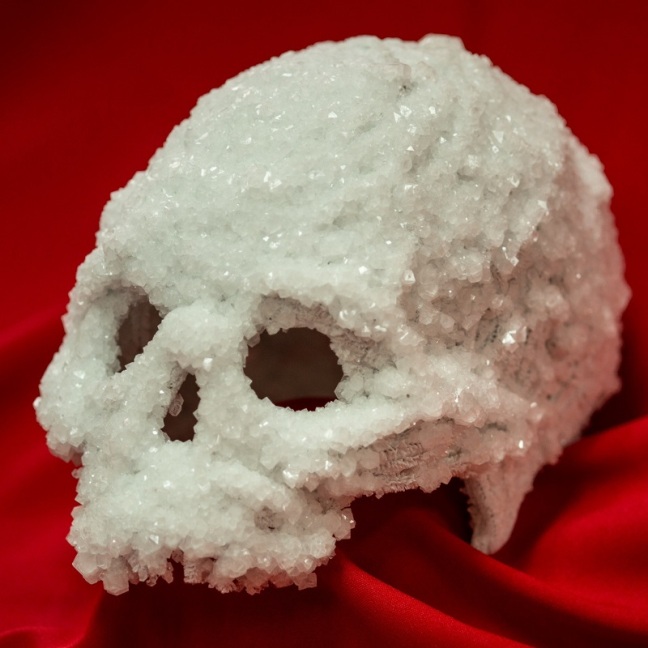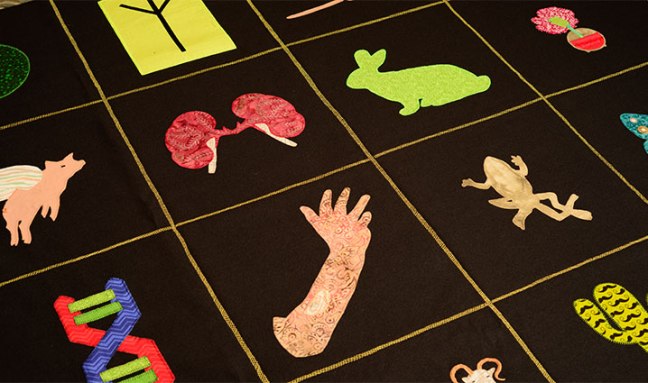Gallery 1855 is celebrating the 2016 Adelaide Fringe Festival this year with bioartist Niki Sperou, who is exhibiting her work in the show Matrix: the body as scaffold for the methodologies and metaphors of science.
It’s the first time Niki has displayed her work at Gallery 1855 and the first time we have featured a bioartist. By definition, Bioart incorporates living organisms or their parts.
Since 2006 Niki has been the resident artist at the department of Medical Biotechnology, Flinders University in South Australia. She draws upon observations from her academic environment, her Greek heritage and art training to conceptualise and complete her artworks.
Her work in Matrix is colourful, unpredictable and most of all thought-provoking… there is a skeleton constructed entirely from Borax crystals, lab-grown bacteria placed in a Petri dish and a neon-coloured quilt depicting works by Australian and international bio artists, a well-known bioscience experiment and more.
All of Niki’s works look at the three-way juncture of art, science and culture, and the common threads. It’s a show that Gallery 1855 habitues will love and one that is bound to entice newcomers.
We caught up with Niki just prior to the exhibition launch on Sunday February 7, to discover more.
Tell us about Matrix – what is your exhibition about? Can you expand on bioart and what it entails?
The term Matrix comes from the Latin and translates to womb or mould; it suggests the facilitation of becoming. I chose Matrix as the title of my exhibition as it speaks to the intersection of art, science and culture. My interest is in the body transformed via recent technological innovations and as such transverses some cultural boundary or norm. Allusion is toward an augmented body, one that achieves some new potential. This is reflected in artworks which have undergone some form of transformation in their production.
Bioart incorporates living organisms or their parts. The biological realm is subject to change.
Including several sub genres Bioart encompasses; genetic art concerned with the coding of life; interventionist art which creates disturbance toward multinational corporations and their products; ecological art and the impact of the anthropocene; art which examines the future potential of biological innovations and the resulting physical, ethical and cultural impacts; the do-it-yourselfers or hackers who enjoy the freedom to utilise materials for applications other than they were designed for.


Why the interest in the field of science? Do you have a background in the field?
I have been the artist in residence at the Department of Medical Biotechnology, Flinders University since 2006. My work satisfies a curiosity toward the nature of living things as well as the language, ethics and culture of science. Art and science have much in common, they are mutually dependent on experimentation and research.

What type of artworks do you create and what about this visual medium appeals to you?
The nature of biology is mutable; this provides inspiration. Further to this, much art is to do with mimesis, working with living things creates a new form of realism. For many years I have worked with living organisms or their parts; blood, bacteria, plants, plant tissue culture. These are usually augmented with scientific media; gel growth media, hormones, antibiotics etc. However traditional art media; drawing, sculpture, textile, photography and items from the domestic are also materials with which I communicate.
I will reference some works in this exhibition; The Ode to Bioart (memory quilt) is a tongue in cheek nod to the seminal works of Bioartists I have met or written about. These images include rabbits, flowers, frogs, pigs and other forms you might see on a domestic quilt, however a second look reveals things more intriguing. It is an attempt to bring the complexities science into the domestic realm.
Trust is a work I created for Toxicity, the first major Bioart exhibition in Canada. By recreating a common experiment for the testing of antibacterials, referred to as ‘Zones of Inhibition’, outside of the laboratory and within a cultural context, the long term effects of imprudent antibiotic use becomes a subject for debate. Highlighted is a need for mindfulness as well as consideration toward the common good with regard to capitalist goods. Within both science and culture power struggles occur as bodies are subjugated and territories are colonised.
Included are photographs of white carnations infused with human blood from my Chimera series. This series is one of my seminal works and speaks to the interconnectedness of living things. At the time of its production there was much hype associated with the mapping of the gene code. We now know that the genetic difference between all living things is quite small. To some this extends to the notion of a collective consciousness.
Matrix, is a skeleton composed of a scaffold of pipe cleaners upon which Borax (a common cleaning product) crystals have been grown. The work is inspired by a lecture series I attended at an AusBiotech convention. The focus of the lectures was a desire to move away from the modernist industrial model of high heat and metal for the production of structures. Instead the soft power of low heat and organic growth was preferred. The structure of bones, a combination of flexible protein and rigid minerals was a suggested model. Since then I have witnessed a trend toward various models of biopolymer matrices to mediate the body.
What do you hope people take away from seeing your works?
I want to bring science into the everyday, to make it accessible and to subject it to critique or contemplation.

I hold a Bachelor of Visual Art and applied Design (Drawing), AC Arts Adelaide and Honours First Class (Sculpture), University of South Australia. In addition to this I have an Advanced Diploma in Dress Design and Garment construction. I have tutored in Art theory at UniSA and have conducted BioArt workshops since 2006 in Australia, Europe and Canada. Art and science has been the focus of articles I have written for publication. I have exhibited with and attended conferences and workshops with renown bio artists.
Can you tell us a bit about your art background, your education, previous exhibitions? What inspires you and your work?
Inspiration often comes from my cultural background; emergent are chimerical works which link Greek culture and biotechnology; fixed classical ideals clash against the fluidity of future potentials.
Dream project? Dream exhibition? Dream venue?
To work in collaboration with talented and inspirational artists and scientists toward a touring international bioart exposition.
Matrix officially opens at 2pm on Sunday 7 February at Gallery 1855, 2 Haines Road Tea Tree Gully. All are welcome.
Niki will also deliver a talk at the Gallery explaining Bioart and her exhibition from 1:30pm, Friday 4 March (allow approximately 1.5 hours). If you are interested, please register here
Matrix exhibition will be held at Gallery 1855 from 10 February until 19 March 2016. Opening hours are Wednesday to Saturday, noon – 5pm.